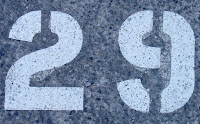There were at least seven Paff brothers in Pittsburgh, but the two giving me trouble are John and Thomas Paff. Thomas married my maternal grandfather's sister, Elizabeth, on January 7, 1930, and they divorced 12 years later in Florida. Although they both moved on and married again, they had 3 children together, so I'd love to know what happened to him.
It's not unusual for genealogy records to contain inaccurate information. Therefore, it's important to analyze each piece of the puzzle and separate fact from fiction. Two key facts that were causing me trouble were Thomas' name and his birth date. And I was hoping that, by determining when he was born, it might lead me to when he died.
Thomas and his older brother John first appeared in the 1910 census. "John P." was 4 years old (abt 1906) and "Thomas F." was 3 (abt 1907). They are listed in the 1920 census as well but with no initials this time, ages 14 (abt 1906) and 12 (abt 1908).
In Ancestry's collection, "Pennsylvania Birth Records, 1906-1908," I found the birth certificate for John Paff. The parents match the census records, so I know I have the right family. The birth is recorded as March 9, 1907. Although I tried other search techniques, I couldn't find Thomas in this database. I browsed the state birth indices, which is often necessary to do as I wrote in a
previous post, but I found no other Paff born to mother Annie until another brother Francis came along in 1910. Thomas' birth record wasn't there.
In 1930, "Thomas J." was married to Elizabeth, and they were living with his parents in Library, Allegheny County, Pennsylvania. The census record shows his age as 23 (abt 1907). A blurb in a local newspaper about the 1930 wedding refers to him as Joseph Paff. So I assumed his full name was Thomas Joseph Paff.
In 1945, three years after his divorce from my great-aunt, "J. Thomas Paff" applied for another marriage license and provided a more specific birth date: November 9, 1907. But wait - I knew the year couldn't be right since his brother was born that same year more than six months earlier. So I still didn't know Thomas' birth date.
The key record for my research was when I obtained a copy of Thomas' first marriage license application from the Allegheny County Orphans' Court. As far as I know this record isn't online yet. And there it was. Date of birth? March 9, 1907. So the birth record I thought was for brother John Paff was actually for Thomas. It appears the J. stands for John and not Joseph, even though there was already a living child named John.
I still need to find out when and where Thomas died, but hopefully I'm a little closer to those answers now. It's interesting how members of our family tree can be difficult to track down even though their births and deaths are relatively recent.








